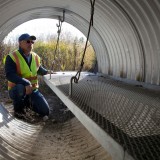Read this article from Tsleil-Waututh Nation on Canada Newswire about their canoe journey from Ambleside Park to Cates Park, and the declaration that came out of it. (September 2, 2012)
Tag Archives: BC Oil Pipelines and Supertankers

Tankers too risky for coast environment
I am, God knows, no scientist and it’s this that made by heart warm when I saw the story in the Vancouver Sun, September 1 at page A5 headlined “Tankers too risky for coast environment, engineers say”.
Three engineers including two professors emeritus from UBC have verified what I and others have been saying for some time. From the story: “Known as Dilbit, diluted bitumen is a mix of heavy crude oil and a condensate that allows it to flow through a pipe, the analysis explains. When Dilbit spills occur, the condensate separates from the bitumen and forms a toxic cloud, poisonous to all life around a spill” …
“And whereas lighter oil floats on the surface of water where it’s easier to clean up, bitumen sinks to the bottom in fresh water and to a level below the surface in saline water.”
“In both cases it is almost impossible to clean up and tides and currents can spread it over vast areas, with severe and catastrophic consequences for fisheries, marine life, and human safety.” (Emphasis added)
This is scarcely the whole picture when we remember that the Enbridge pipeline travels 1100 kms over the world’s most formidable terrain where the spills are many times more likely to happen than on the coast and will be unreachable by the company which won’t be able to do anything about them anyway. Because these spills will remain, we have a serial polluter on our hands with each new spill adding a new area of devastation.
There is another area no one seems to want to talk about – vandalism or terrorism. We have seen examples of this with gas lines in the Peace area – why do we ignore them with Enbridge and the Kinder Morgan lines.
Yet one more area of concern is how the public and the authorities ever know if there’s a spill on either of these lines. Kinder Morgan has had spills in populated areas but have there been others along their lines that have simply been repaired with none any the wiser?
It’s past time for Premier Clark to make it clear that the Province opposes both the pipelines and the tanker traffic and will do all in its power to prevent them from happening.

The Enbridge Pipeline – it’s all about PR now
Today is dedicated to the 51% the polls say could be swayed by evidence and support the Enbridge Northern Gateway pipeline proposal.
To recap, The pipeline proposed runs 1,100 kms. through the Rockies, the Rocky Mountain Trench, through the Coast Range getting to the ocean at Kitimat thence by tanker through the Douglas Channel to China. This is some of the roughest terrain in the world and Douglas Channel is an extremely dangerous waterway.
The pipeline would pass over 1000 rivers and streams. many of them critical to our salmon runs.
The issue is not whether or not there will be spills for we know that for certainty – in fact we know by Enbridge’s own documents that they have more than a spill per week. In short, the mathematics of statistics tells us spills on land and sea are inevitable.
Earlier in the week we heard from Enbridge that bitumen is the same as ordinary crude when it’s spilled, as if that would make everything OK.
We are now seeing the public relations world at work. I know something about the philosophy behind Public Relations companies and their siamese twin, the advertising company. I have done some work for a large PR firm and saw lots of advertising flacks at work when I was in government. If I were to say that these people told lies they would rise as one in protest. OK, they don’t tell lies in the same way Bill Clinton didn’t lie when he said he had never had sex with Monica Lewinsky.
If you want to observe the the ethics of the industry, go to a Third World Country and look at their advertisements for tobacco companies. It will remind you of North America in the 50s with the modern equivalent of “More Doctors Smoke Camels Than Any Other Cigarette”. Take a look, for example, at Shell Oil ads, then remember their record in Nigeria where they have the government bought and paid for and are generally believed to have had Ken Saro-Wiwa, the activist and journalist, murdered by the state.
I am not suggesting that Enbridge has contracts out on anyone, just that the industry they employ, and the PR people on staff, are in the same business as the giant PR firm Hill and Knowlton, famous for tobacco ads and making the 1984 Union Carbide’s disaster in Bhopal India appear as if they had conferred a benefit on the local population – well, not quite, but you get my drift.
We’ve seen evidence of this in the now famous cartoon Enbridge put out showing the Rockies and Coast Range mountains as pimples and deleting all those troublesome islands in Douglas Channel.
The spin now is, of course, that bitumen, the gunk from the tar sands, is no more toxic or different to clean up than crude oil. Not only is that bull shit, it’s a typical PR way of making the bad look good by comparing it to something else not quite so bad. It’s the PR way of “bait and switch”. It is hoped that the public will accept that bitumen is no worse than crude, heave a sigh of relief saying thank God, I was afraid that bitumen was really bad for the environment.
I write this piece today to newcomers to this issue to warn them that the pipeliners and tanker people have their PR and advertising folks in action.
It is well that we remember, as we enter the corporate crap phase of this issue, just what corporations are all about. Their mandate is a simple one – make money for shareholders. It is not part of their mandate to provide decent paying jobs, workplace safety or protection of the environment. To the extent that they do these things it is what they’ve been forced to do by market forces or governments.
One need only look again at Third World countries and see how companies like Shell, Rio Tinto or The Reynolds Corporation operate when they are free from government rules (usually because they have bought off the governments).
I’m no communist or socialist just a realist who, as an octogenarian, has seen quite a bit of life’s truisms pass before his eyes.
Here is something you can take to the bank – if Enbridge tells the truth about any part of their policy it’s only by accident or it’s in its interest to do so. They couldn’t care less about British Columbia, its fish and wildlife or its wilderness.
The environmental concerns of the people of British Columbia are of no concern to the company.
We’d all better understand this if we want to keep our beautiful and bountiful province intact for generations to come for whom we hold it all in trust.
Ride the Pipe: Michelle Staples
Read this blog posting by Michelle Staples at Ride the Pipe, a project to engage with and photograph the people most affected by the proposed Northern Gateway Pipeline and to capture the landscapes and seascape that will be altered by construction or destroyed by an accidental oil spill. (August 24, 2012)
Read more: http://ridethepipe.ca/blog/michelle-staples/
Former DFO Manager, Minister: Harper ‘Disembowelled’ Science Budget for Enbridge Review
Read this story from the Vancouver Sun on evidence that despite his feigned commitment to “listen to science” on the proposed Enbridge Northern Gateway Pipeline, Prime Minster Stephen Harper has “disembowelled” the science budget for the pipeline review. (Aug. 20, 2012)
VANCOUVER – While Prime Minister Stephen Harper says the fate of Enbridge’s proposed pipeline from the Alberta oilsands to tankers on the British Columbia coast will be based on science and not politics, documents show some of that science isn’t forthcoming.
And critics say there is no time for the science to be completed before a federal deadline for the environmental assessment currently underway.
Documents filed with the National Energy Board show the environmental review panel studying the Northern Gateway project asked Fisheries and Oceans Canada for risk assessments for the bodies of water the proposed pipeline will cross. The pipeline is to traverse nearly 1,000 streams and rivers in the upper Fraser, Skeena and Kitimat watersheds.
The department didn’t have them.
“As DFO has not conducted a complete review of all proposed crossings, we are unable to submit a comprehensive list as requested; however, this work will continue and, should the project be approved, our review will continue into the regulatory permitting phase,” DFO wrote in a five-page letter dated June 6, 2012.
The response went on to say there “may be differences of opinion” between the company and the department on the risk posed by the pipeline at some crossings. It provided two examples of crossings of tributaries to the Kitimat River where Enbridge rated the risk as low but Fisheries rated it medium to high.
DFO said the federal ministry will continue to work with the company to determine the risk level and level of mitigation required.
“DFO is of the view that the risk posed by the project to fish and fish habitat can be managed through appropriate mitigation and compensation measures,” said the department’s response.
“Under the current regulatory regime, DFO will ensure that prior to any regulatory approvals, the appropriate mitigation measures to protect fish and fish habitat will be based on the final risk assessment rating that will be determined by DFO.”
Earlier this month, Harper told reporters in Vancouver that “decisions on these kinds of projects are made through an independent evaluation conducted by scientists into the economic costs and risks that are associated with the project, and that’s how we conduct our business.”
He went on to say “the only way that government can handle controversial projects of this manner is to ensure that things are evaluated on an independent basis, scientifically, and not simply on political criteria.”
But the federal government recently sent letters to 92 habitat staff members within Fisheries and Oceans in B.C., telling them that their positions will be cut. Thirty-two of them will be laid off outright.
The cuts will mean the department in B.C. has half the habitat staff it had a decade ago.
All but five of the province’s fisheries field offices will be cut as part of a $79 million — 5.8 per cent — cut to the department’s operational budget, including the offices in Prince George and Smithers that would have had the lead in monitoring pipeline effects.
The marine contaminant group that would have been involved in a spill in B.C. has been disbanded and the fisheries and environmental legislation gutted, said Otto Langer, a retired fisheries department scientist.
“He (Harper) says the science will make the decision. Well he’s basically disembowelled the science,” said Langer. “It’s a cruel hoax that they’re pulling over on the public.”
Former federal Liberal fisheries minister David Anderson agrees.

Audio: Damien Gillis Discusses Energy and BC’s Economy on Co-op Radio
Check out this interview from Aug. 15 on Vancouver Co-op Radio’s “Discussion”, with host Charles Boylan. Guest Damien Gillis and Boylan cover a wide range of topics relating to energy and the future of the BC and Canadian economy. The pair discuss the myriad alternatives popping up of late to the embattled Enbridge pipeline, including Kinder Morgan’s planned twinning of its Trans Mountain Pipeline to Vancouver, and shipping bitumen by rail. They also cover natural gas development in northern BC – including controversial hydraulic fracturing and the building of a new pipeline to carry this gas to Kitimat and covert it to Liquified Natural Gas to sell in Asian markets – plus an alternative economic vision for BC that doesn’t depend on becoming a major fossil fuel corridor to the world. (Aug. 15 – 1 hr)

Refining the Black Stuff in Kitimat Doesn’t Make Sense
One must, I suppose, take newspaper tycoon David Black’s offer to build a refinery near Kitimat seriously, although the idea is preposterous on several fronts.
For openers, he doesn’t tell us who will be behind such a refinery. He admits he doesn’t have the money – an important matter.
Of course, Mr. Black tosses out employment as jelly bean for us to enjoy, citing 6,000 jobs over the six year construction period and 3,000 long-term in the operation of the refinery. He doesn’t mention any research on this issue – one must take these numbers with the skepticism which always rightly greets announcements of undertakings like this.
Mr. Black ignores the fundamental issues here.
He ignores the certainty that the pipeline will continue to have spills of bitumen – Enbridge averages one per week – and BC will watch as its wilderness is incrementally destroyed.
It’s interesting to note that Mr. Black doesn’t deny the dangers from oil tankers but allays our fears by saying that because refined oil and gasoline will be replacing bitumen, that our worries are over!
What also is puzzling is the timing of this announcement.
Mr. Black is a self-made billionaire who admits that he knows bugger all about refineries. This suggests that he has some backers in the oil business who are a bit shy about having their pictures in the papers.
Wasn’t the deal that the main customers were Chinese who want the raw bitumen to refine themselves?
Was this idea from David Black? If it means anything at all it must be a diversion to focus on jobs! Jobs!
The announcement attracted attention – but when one reads it, it’s a damp squid.
In my view, the public will have no trouble seeing this proposition for what it is – environmentally unacceptable and as not only no improvement on the Enbridge proposal but, on analysis, worse.
Mr. Black should stick to publishing newspapers.
BC Media Mogul David Black Proposes $13 Billion Refinery in Kitimat Linked to Enbridge Pipeline
Read this story from the Vancouver Sun on BC media mogul David Black’s proposal to build a $13 Billion refinery in Kitimat to process Alberta bitumen from the Enbridge pipeline. (Aug 17, 2012)
VANCOUVER – B.C. community newspaper tycoon David Black proposed today building a $13-billion oil refinery near Kitimat to use all of the crude from Enbridge’s controversial Northern Gateway pipeline.
It would mean tankers would ship refined fuels like gasoline off of B.C. northwest coast, not heavy oil from Alberta, reducing environmental risks, says Black.
A refinery also promises 10 times as many jobs as an export pipeline.
See more David Black photos here
Black is hoping his proposal will change opposition from British Columbians and first nations, many of which have rejected the $6-billion project because they say the economic rewards for B.C. are not great enough to offset the risk and consequence of an oil spill on the pipeline or off the northwest coast of British Columbia.
Last month, B.C. Premier Christy Clark also declared the province would not even consider the Northern Gateway project unless it gets a much greater share of the economic benefits.

Cartoonist Murphy at it again: New video mocks Enbridge’s route animation
Province cartoonist Dan Murphy is back at it – poking fun at Enbridge’s laughable marketing campaign for the proposed Northern Gateway Pipeline. (Incidentally, The Common Sense Canadian first alerted the public to Enbridge’s deceptive animated map back in February).
This time, it’s a spoof on the company’s bucolic animation of the pipeline and tanker route, derided by the public and media of late for its airbrushing out of the significant geolocial and environmental challanges to the project posed by BC’s rugged landscape and coast. This latest cartoon comes on the heels of the one he made several months ago, taking on the company’s newly-launched TV ad. That spoof stirred up major controversy as it emerged Enbridge had leaned on The Province’s parent company, Postmedia, to yank the cartoon, under threat of pulling a million dollars of advertising from the media chain. Murphy bravely went public with the situation, which helped the cartoon to go viral, giving both the paper and Enbridge a black eye in the process.
Check out Murphy’s latest cartoon:
Global TV: Enbridge Under Fire for Misleading Animation of Pipeline, Tanker Route
Watch this video news story from Global TV on the controversy over Enbridge’s pipeline and tanker route animation, which is drawing criticism for its misleading portrayal of Douglas Channel without the many navigational impediments it contains. The Common Sense Canadian broke this story months ago with this story by Damien Gillis. (Aug. 15, 2012)
Watch video here: http://www.globaltvbc.com/video/index.html?v=Is64y8ASHdAdTsYZEpfELzqMJHMzKE46#news+hour+final
